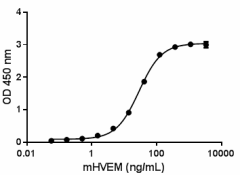- Regulatory Status
- RUO
- Other Names
- CD272, B- and T-lymphocyte attenuator, B- and T-lymphocyte-associated protein

-

Immobilized recombinant mouse BTLA at 1.0 µg/mL binds recombinant mouse HVEM in a dose dependent manner with EC50 of 15 - 60 ng/mL. -

Stability testing for Mouse BTLA. Mouse BTLA was aliquoted in PBS, pH 7.2 at 0.2 mg/mL. One aliquot was frozen and thawed four times (4x freeze/thaws), and compared to a control kept at 4°C (control). The samples were tested for their ability to bind mouse HVEM in a functional ELISA.
| Cat # | Size | Price | Quantity Check Availability | ||
|---|---|---|---|---|---|
| 775802 | 10 µg | $65.00 | |||
| 775804 | 25 µg | $94.00 | |||
| 775806 | 100 µg | $335.00 | |||
Select size of product is eligible for a 40% discount! Promotion valid until December 31, 2024. Exclusions apply. To view full promotion terms and conditions or to contact your local BioLegend representative to receive a quote, visit our webpage.
BTLA (B and T lymphocyte attenuator, CD272) is a type I transmembrane glycoprotein with four extracellular cysteine-rich domains. It is an inhibitory molecule structurally and functionally similar to cytotoxic T lymphocyte antigen-4 (CTLA-4) and programmed death-1 (PD-1). These molecules belong to the immunoglobulin superfamily that binds B7 family members. Different from CTLA-4 and PD-1 binding with the B7 family members, BTLA interacts with herpes virus entry mediator (HVEM) which belongs to TNFR family. BTLA/HVEM interaction was the first demonstration of crosstalk between these two family members. BTLA/HVEM interaction negatively modulates T cell activation. HVEM induces BTLA tyrosine phosphorylation and inhibits T-cell proliferation. There is accumulating evidence suggesting that BTLA/HVEM signaling also plays an important role in autoimmunity and infection at mucosal surfaces. The BTLA/HVEM interaction does not prevent the simultaneous binding of other HVEM ligands such as LIGHT or Lymphotoxin-alpha. BTLA is expressed on T cells, B cells, macrophages, dendritic cells, and natural killer cells. Constitutive expression level of BTLA on resting T cells are very low, but increase after the activation of T cells. BTLA is highly expressed on resting B cells.
Product Details
- Source
- Mouse BTLA, amino acids Glu30-Gly177 (Accession # Q7TSA3) with a C-terminal human IgG1 (Pro100-Lys330) Fc tag expressed in 293E cells.
- Molecular Mass
- The 387 amino acid recombinant protein has a predicted molecular mass of approximately 43.5 kD. The DTT-reduced protein migrates at approximately 60 kDa and and non-reduced protein migrates at approximately 115 kDa by SDS-PAGE. The predicted N-terminal amino acid is Glu.
- Purity
- >95%, as determined by Coomassie stained SDS-PAGE.
- Formulation
- 0.22 µm filtered protein solution is in PBS, pH 7.2
- Endotoxin Level
- Less than 0.1 EU per μg cytokine as determined by the LAL method.
- Concentration
- 10 and 25 µg sizes are bottled at 200 µg/mL. 100 µg size and larger sizes are lot-specific and bottled at the concentration indicated on the vial. To obtain lot-specific concentration and expiration, please enter the lot number in our Certificate of Analysis online tool.
- Storage & Handling
- Unopened vial can be stored between 2°C and 8°C for up to 2 weeks, at -20°C for up to six months, or at -70°C or colder until the expiration date. For maximum results, quick spin vial prior to opening. The protein can be aliquoted and stored at -20°C or colder. Stock solutions can also be prepared at 50 - 100 µg/mL in appropriate sterile buffer, carrier protein such as 0.2 - 1% BSA or HSA can be added when preparing the stock solution. Aliquots can be stored between 2°C and 8°C for up to one week and stored at -20°C or colder for up to 3 months. Avoid repeated freeze/thaw cycles.
- Activity
- When mouse BTLA is immobilized at 1.0 µg/mL (100 µL/ well), recombinant mouse HVEM binds with EC50 of 15 - 60 ng/mL in a functional ELISA.
- Application
-
Bioassay
- Application Notes
-
BioLegend carrier-free recombinant proteins provided in liquid format are shipped on blue ice. Our comparison testing data indicates that when handled and stored as recommended, the liquid format has equal or better stability and shelf-life compared to commercially available lyophilized proteins after reconstitution. Our liquid proteins are verified in-house to maintain activity after shipping on blue ice and are backed by our 100% satisfaction guarantee. If you have any concerns, contact us at tech@biolegend.com.
Antigen Details
- Distribution
-
T cells, B cells, macrophages, dendritic cells, and natural killer cells.
- Function
- Lymphocyte inhibitory receptor which inhibits lymphocytes during immune response.
- Interaction
- Lymphocytes
- Ligand/Receptor
- HVEM
- Bioactivity
- Measured by its ability to bind mouse HVEM
- Cell Type
- B cells, Dendritic cells
- Biology Area
- Cancer Biomarkers, Cell Biology, Immunology, Inhibitory Molecules
- Molecular Family
- Immune Checkpoint Receptors, Soluble Receptors
- Antigen References
-
- Watanabe N, et al. 2003. Nat. Immunol. 4: 670-9
- Gavrieli M, et al. 2003. Biochem. Biophys. Res. Commun. 312: 1236-43
- Gonzalez LC, et al. 2005. Proc. Natl. Acad. Sci. 102: 1116-21
- Sedy JR, et al. 2005. Nat. Immunol. 6: 90-8
- Murphy KM, et al. 2006. Nat. Rev. Immunol. 6: 671-81
- Gene ID
- 208154 View all products for this Gene ID
- UniProt
- View information about BTLA on UniProt.org
